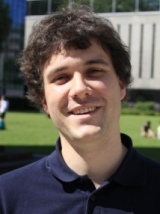Bob Schroeder from the CPE reports on the 2013 Nobel Laureate Meeting

Bob Schroeder from the CPE shares his experiences from the 2013 Nobel Laureate Meeting
 From 30th June to 5th July the 63rd Lindau Nobel Laureate meeting was held on the shores of Lake Constance in Lindau. The Nobel Laureate meetings were founded in 1951 with the aim to unite people again after the WWII through science. Were the first meetings rather small and intimate, they have grown significantly in size since the early 50s. This year's Chemistry meeting was attended by 35 Nobel Prize winners and some 600 young scientists from all over the world. Thanks to the support of Profs Donal Bradley and Iain McCulloch, I applied to the Royal Society in a first round. After taking that hurdle, the ball was with the organisers of the Nobel laureate meetings to take the final decision. I was quite surprised and delighted, when the confirmation email from Lindau popped-up in my e-mail inbox in early March. I mean, how often does one get the chance to meet face to face with Chemistry Nobel Laureates, whose theories one had to study during undergrad lectures?
From 30th June to 5th July the 63rd Lindau Nobel Laureate meeting was held on the shores of Lake Constance in Lindau. The Nobel Laureate meetings were founded in 1951 with the aim to unite people again after the WWII through science. Were the first meetings rather small and intimate, they have grown significantly in size since the early 50s. This year's Chemistry meeting was attended by 35 Nobel Prize winners and some 600 young scientists from all over the world. Thanks to the support of Profs Donal Bradley and Iain McCulloch, I applied to the Royal Society in a first round. After taking that hurdle, the ball was with the organisers of the Nobel laureate meetings to take the final decision. I was quite surprised and delighted, when the confirmation email from Lindau popped-up in my e-mail inbox in early March. I mean, how often does one get the chance to meet face to face with Chemistry Nobel Laureates, whose theories one had to study during undergrad lectures?
Understandably the excitement was high the day I left for Lindau. Lindau is an historic Bavarian town next to Lake Constance and because of its small size and geographical location it is perfectly suited for this special event. Straight from the beginning it became obvious that this was not an ordinary scientific meeting. Every participant was very eager to meet new people and to chat about their research and interests, Nobel laureates included. Because the meeting was held on the small island of Lindau, one could not escape the atmosphere and was constantly running into participants, which catalyzed many interesting discussions especially in the charming bars and restaurants of Lindau. To everyone’s delight there were no boundaries whatsoever between the Nobel laureates and the young researchers, in contrary they were very modest and happy to share their experiences in science and life.
A typical day in Lindau would start with a science breakfast in the morning, during which a discussion panel would address issues ranging from the importance of surface chemistry to the usefulness and beauty of quantum mechanics. After the breakfast, the day would continue with a series of half hour lectures given by the different Nobel Laureates. The topics of the lectures were very diverse, whereas some Nobel Laureates like Prof Brian Kobilka choose to discuss their ongoing research; others like Profs Steven Chu and Mario Molina decided to address current global issues like energy security and climate change. The afternoons were filled with a manifold of activities, consisting of discussion panels on why communication is important for scientists, lectures with various Nobel Laureates on their research topics and discussion sessions during which the Nobel Laureates answered whatever questions the students came up with. On Friday, the meeting concluded with a boat trip to the garden island of Mainau, where José Ramos-Horta (Nobel Laureate, Peace 1996) and Gunnar Stalsett (Member of the Nobel Peace Prize Comitee) were debating over the 21st century challenges to peace and justice.
Overall the Nobel Laureate Meeting in Lindau was a “once in a lifetime” event and I am very grateful that I was given the opportunity to attend. Something that personally struck me throughout the meeting was the enthusiasm of the Nobel Laureates for science and humanism or to put it in the words of Prof Steven Chu’s closing remarks: ”You are a scientist, but you are a human being first.”
Article text (excluding photos or graphics) © Imperial College London.
Photos and graphics subject to third party copyright used with permission or © Imperial College London.
Reporter
Lisa O'Donnell
Department of Physics